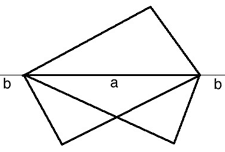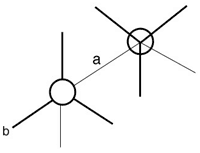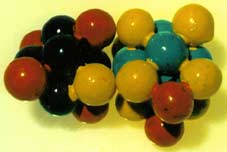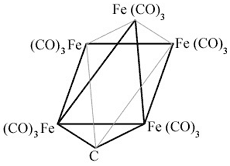by, Sithamalli K. Balasubramanian - Ph.D.

Fig. 6 - ‘a’ Inverted
Bond, ‘b’ Tetrahedral Bond.

Fig. 7 - Inverted bond projection diagram.
The Single Bond: The square carbon atom:
The square ‘planar’ carbon atom has been an intriguing problem for the theoretician. Several authors have speculated on it and have concluded that it is unlikely to exist in simple covalent state {ref.11}. The energy difference between the square planar and the tetrahedral carbons had been estimated to be 160 K.Cal/mole {ref.12}. The square pyramidal carbon had been estimated to be more stable than the planar carbon by about 26 K.Cal/ mole.
Our model provides for a square planar carbon as a possibility of intermediate strength between the tetrahedral and the inverted bond. There is no factor inhibiting the formation in our model except the repulsion between the closely placed bonded electrons.
A square bonding pattern would be facilitated in compound formation with another ‘square’ atom. Such a situation is encountered in the case of carbon monoxide in which carbon is quadruply bonded to oxygen, as shown in model (8). The oxygen ‘structure’ is tentative and is derived from other considerations, in particular, the magnetic inversion at oxygen in anti-ferromagnetic systems. The bond order for carbon monoxide is 2.76 making each bond of the square atom 69% as strong as the single tetrahedral bond. This value could also be a measure of the maximum strength of the q-surface bond and was used to deduce the strength of the inverted bond. ...top

Fig. 8 - Carbon
monoxide model.
The quadruple bond is in agreement with the high dissociation energy of carbon monoxide and its stability. The presence of two non-bonded b-surfaces in carbon monoxide would make it particularly susceptible to further bonding. This anticipation is borne out by the ease of formation of a wide range of metal carbonyls in which the carbon is to be considered hexavalent and all carbon-metal bonds whether single or double are covalent.
The square atom would be facilitated by ‘long’ bonds which would minimize the repulsion between bonded electron pairs, as is found in the square pyramidal iron carbonyl complex (9) {ref.13}. All the metal carbonyl and the metal bare atom bonds are covalent as the complex is soluble in petroleum ether. According to our model the carbido carbon is tetravalent, the implication being that there is no bond between the apex iron and the bare Carbon atom. This is in agreement with the observation that the apex Fe to bare carbon distance (196 pm) is more than the base Fe to bare Carbon distance (187-190 pm) This view is in contrast to that of some authors {ref.14}.

Fig. 9 - Iron carbonyl carbon complex.